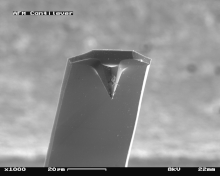Cantilever (microscope)
The measuring needle of an atomic force microscope (AFM) is called a cantilever . This typically consists of an approximately 3.4 mm long and 1.6 mm wide substrate surface on which there is a spiral spring 100 to 300 µm in length, 20 to 80 µm in width and 1 to 3 µm in thickness produced by etching technology . The large area is used for clamping in the AFM measuring head and as a reflection surface, for example to reflect the light of a laser in order to be able to detect changes in movement. For this purpose, a metal layer is usually vapor-deposited onto the surface as a reflective layer (bimetal). As a starting material for the preparation are usually silicon - wafer used as they are known from the semiconductor industry. In addition to silicon, the very hard silicon nitride (Si 3 N 4 ) is also used as a material for cantilevers.
The actual measuring needle has what is known as a tip at its foremost end - a point that ideally tapers to a width of just a few atoms. The tip radii are 10 nm to 15 nm for normal tips, and 5 nm and less for particularly sharp tips . Due to their geometry, cantilevers are manufactured with a resonance frequency of a few kilohertz (kHz) up to 300 kHz and spring constants between 0.01 N / m and several hundred N / m.
For individual measurement modes, which are described in more detail under the term atomic force microscope , it can be e.g. B. it may be necessary that the cantilever is electrically conductive. Measuring needles sputtered or vapor-coated with platinum or gold are offered for this purpose . There are also AFM tips with magnetizable surfaces on which ferromagnetic substances are applied. The layers used are only a few 10 nm thick in order not to impair the tip radius and thus ultimately the resolution of the device. In some cases, the back is also vapor-coated with aluminum or gold so that it better reflects the laser beam with which its deflection is detected by the AFM.
As an alternative to the simple bar shape, there are also cantilevers that taper towards the front in a triangular shape from a wide part of the substrate. These have a higher rigidity against torsional forces, which occur due to the horizontal scanning movement of the AFM and are usually perceived as a disturbance.
literature
- John E. Sader, Ian Larson, Paul Mulvaney, Lee R. White: Method for the calibration of atomic force microscope cantilevers. In: Review of Scientific Instruments. 66, 1995, p. 3789, doi : 10.1063 / 1.1145439 .
- John E. Sader, James WM Chon, Paul Mulvaney: Calibration of rectangular atomic force microscope cantilevers. In: Review of Scientific Instruments. 70, 1999, p. 3967, doi : 10.1063 / 1.1150021 .


